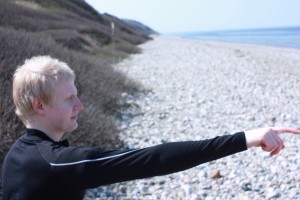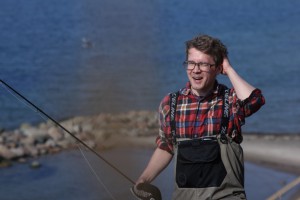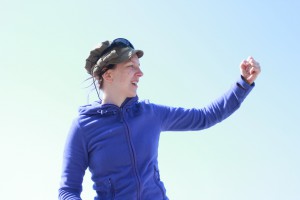I live in Copenhagen. Last years’ first fishing trip was on Good Friday with my girlfriend Johanna, and my bass player friend Joel. It was a nice and we caught some cod on a spinning rod, so I thought it could be nice to make it an annual event to go fishing on easter, and maybe even start a new tradition.
PART 1 – THE PLAN
By now, Joel had also gotten into fly fishing, so this time we would be fly fishing for trout instead of spinning fishing for cod. Even though I have tried many times, I had not ever caught a seatrout except for one of 2.2kg in a Norwegian salmon river Repparfjordelva. My coastal fly fishing experiences have always drawn a zero-result. I knew that Denmark is supposed to be one of the best places to catch the big seatrout, but for that we needed to get out of Copenhagen so the plan was to rent a car for that day. I made a waterproof plan with some second hand knowledge of where the trout should be, and how to catch it. Also there was some limitations since we only had one day. Here’s how I made the plan:
- Range: We only had one day, and starting 9:00 am, that meant that we were staying on the danish island Sjælland.
- Weather: The forecast was sunny and warm with east wind of 6-10m/s. According to my sources, this wind was enough to whitewash the eastern coast that was the most exposed to wind. So I decided to exclude all places on the east coast.

Forecast for Denmark on 22.04.2011
- Terrain: We needed relatively easy access with car, preferably out of major cities. In all my experience of not catching seatrout, I gathered some information on where the seatrout would most likely be – or at least where it wouldn’t be: The place should have a varied depth, some underwater features like rocks. A mixed type bottom with sand, rocks and seaweed was also supposed to be good. We also needed nearby facilities like the toilet, we didn’t want to abandon our spot to just find a place to take a shite. I used the google maps to look at satellite images, and the street view to take a closer look. Somehow the north coast sounded more appealing to me than the south coast, so I started there. The satellite images showed mostly very few features on the coastline, so I came up with a few options. Hornbæk Strand and Nakkehoved looked like trout country to me. But then I found a place at Rågeleje with nice hills and a mixed bottom type. Satellite showed a sandy beach with steep hills and lots of underwater features. Streetview showed easy access with a toilet. This was looking good.

Google Maps' Streetview shows access to seatrout paradise and a nearby toilet

The satellite of Rågeleje beach. The darker areas would be hot for seatrout.
- Intel: I got some information from Klaus from Guideline (who lives on the east coast of Denmark), but had not a lot of sources of information, so I searched the internet. I found a place where they gather fishing reports called fangster, where I found out that this huge 4.1kg sea monster had been caught just 10 days earlier on the very same beach I had been searching. This was enough. We were going there!

4.1kg
PART 2 – THE FISHING
Everything had gone almost according to plan and we were ready at the beach at 11:30, and everything was looking good. The turquoise water, slight sidewind breeze, high tide – we had all the parameters.

Joel Fishing - The place looked good - maybe too good?
Me and Joel were going with waders and fly fishing while Johanna was fishing with the spinning rod. We didn’t feel anything. We saw nothing. Still it felt very promising. The place was very beautiful and the weather was good, so we moved along the coastline and had lunch.
We met some Danish fishermen, who used to fish there for years. I asked: “Have you caught anything?” “-No, I haven’t… I think the best time was in the morning or then in the evening. I don’t think anything is going to happen at mid day.”
Okay, maybe we were too late then. But surely there must be some fish active later in the day. or the evening. At least the weather was perfect.
We met some other local fishermen and I asked: “Did you catch?” They replied: “Well… Not this time. The weather is too good. Too much sunshine. Too little wind.”
It seemed like every time I was fishing for seatrout, there was something wrong. Maybe it was the bad planning, or really ugly weather, or too cold or too warm, or just wrong place. But this time I had the feeling that maybe the conditions were just too good.
So the rest of the day was business as usual, lot’s of casting practice and no fish.
And once again the only question I had in mind was: Where is trout?
Well. It was good times anyways, and having fished for seatrout for dozens of hours without catching, I didn’t expect much either. It was fun to try out my father’s old Takumar lenses. I had the 105mm f/2.8 and the 35mm f/3.5. Nice and sharp lenses – I must say, and very good manual focus rings.
If you have gotten some seatrout, and know how to find one, and even catch one. Please help! If you have some advice, what went wrong this time, and what we should have done differently, please tell me!
For me, the seatrout remains a myth, and I will continue to investigate. I will have to build up my confidence with something that I know I can catch, like the arctic char, or the brown trout. Please submit your advice in the comments below, or by email to address jazznflyfishing@gmail.com.

Maybe trout is there?

Joel wondering - Where is trout?

Johanna lifting the imaginary 2,5kg by the tail

Trout paradise?











Recent Comments